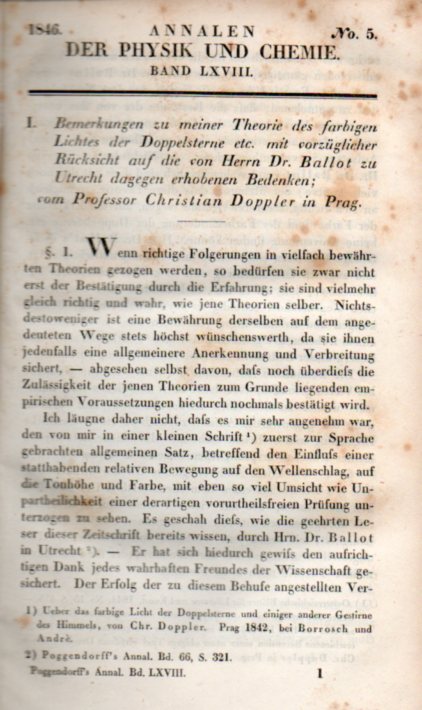Christian Doppler. “Bemerkungen zu meiner Theorie des farbigen Lichtes der Doppelsterne etc. mit vorzüglicher Rücksicht auf die von Herrn Dr. Ballot zu Utrecht dagegen erhobenen Bedenken”. Published in the Annalen der Physik, by the publisher Johann Ambrosius Barth, in Leipzig, 1846, band 68, no. 5, part 1, pages 1-35. ¶ First edition SOLD

Offered as part of the entire half-year of the publication, numbering some 582pp. The volume is bound in black half-cloth and very dark green/black mrabled boards. Exlibris (a) Provinzial Gewebbschele zu Aachen, then (b) Deutsche akademie der Luftfahrtforschung, and then (c) Wright Field Library (Dayton, Ohio), and finally (d) the Library of Congress. There are ownership rubber stamps on text block page edge at top and bottom, a stamped gilt title on the bottom of the spine, and two scant stamps on the contents page, and that's it. Very nice, tight, fresh copy.
This is a further extention of Doppler's epochal “Ueber das farbige Licht der Doppelsterne und einiger anderer Gestirne des Himmels,” which appeared in Abhandlungen der Konigl. Böhmischen Gesellschaft derWissenschaften, (5th ser., 2 (1842), 465, and which was also published separately in Prague in the same year, 1842) in which the idea of motion is expressed to both source and observer. “ The Doppler Theory/Doppler shift is of monumental applicability and importance, providing the foundation for sonar and radar, as well as for the general acceptance of the cosmological theory of the Big Bang (showing how the shift in the spectra of astronomical entities allows for the measurement of the rate of recession relative to the Earth.
“In 1846 Doppler published a revised version of his principle where he considered both the motion of the source and the motion of the observer. Later, a French physicist, Armand Hippolyte Louis Fizeau (1818–1896), who made one of the first measurements of the velocity of light, generalized Doppler’s work by applying his theory not only to sound but also to light.”-- A. Roguin, "Christian Doppler, the Man Behind the Effect". The British Journal of Radiology, 75 (2002), 615–619
Also contained in this volume is a significant paper by Michael Faraday, the first German edition of "Thoughts on Ray Vibration", which suggests that no ether or other vibrating material is responsible for the transmission of light.
Bibliography of Doppler’s work. In: Stoll I, editor. The Phenomenon of Doppler. Prague, Czechoslovakia: Czech Technical University, 1992:76–80.




Comments